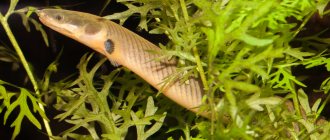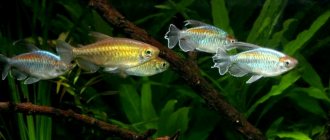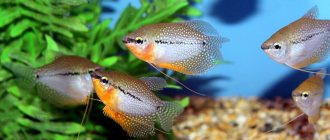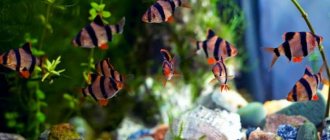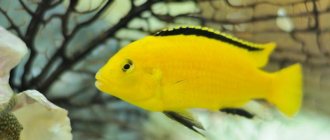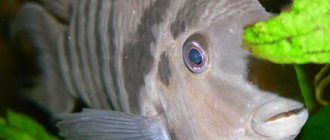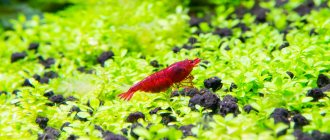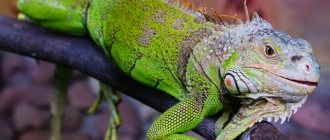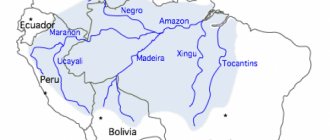Habitat in nature
Melanothenia neon was first described by Weber in 1922, but appeared in the aquarium hobby in the 90s. They live in small rivers and streams in Western New Guinea, and in the Mamberamo region of West Papua.
The water in such rivers is clear, with a fast current, a temperature of 24-27C and a pH of about 6.5. Melanothenia feed on plant foods, insects, fry and caviar.
Fortunately, these areas still remain some of the least explored on the planet, and the rainbowfish population is not yet in danger.
Range and Habitat
Asia: Mamberamo River in North Irian Jaya, Indonesia.
Endemic to the Mamberamo river system, New Guinea, Indonesia. It is one of the largest river systems on the island, with a length exceeding 2000 km.
It lives both in fast tributaries of the river and in the surrounding ponds and wetlands. Prefers places with dense vegetation and lots of snags.
Description
Melanothenia neon is externally a typical representative of the genus of iris, except perhaps for its size. It reaches a length of 5-6 cm, rarely more, for which it is also called dwarf.
Life expectancy is about 4 years, but can vary between 3-5, depending on the conditions of detention.
Its body is elongated, laterally compressed, with wide anal and dorsal fins, and the dorsal fin is forked.
The neon iris has bright fins, red in males and yellowish in females.
The body color is pinkish-gray, but the scales have a blue tint and create a neon effect at different lighting angles.
Maintenance and care, design of the aquarium
The optimal aquarium size for a flock of 6–8 fish starts from 60 liters. The design uses a variety of rooting and floating plants, arranged in groups to maintain open areas for swimming. The fish does not react well to bright lighting and excessive water movement, so equipment should be selected based on these characteristics. Another important factor is water quality. A productive filtration system and regular replacement of some of the water with fresh water will ensure suitable conditions for keeping the Neon Rainbow.
Feeding
Neon rainbowfish in nature eat both plant and animal foods. In the aquarium, they happily eat high-quality artificial food, but it is important not to overfeed and use food that sinks slowly.
Neons hardly collect food from the bottom, so those that sink quickly are not suitable.
Additionally, you need to feed with live or frozen food: bloodworms, tubifex, brine shrimp.
They also love plant foods; you can give them pre-cooked lettuce leaves, pieces of zucchini, cucumber, or food containing spirulina.
Breeding/reproduction
Breeding Rainbowfish is possible both in a general and in a separate spawning aquarium. Favorable conditions for the beginning of the mating season are achieved at a temperature of 26–28°C, in slightly alkaline (pH 7.5) water of medium hardness. The design should include thickets of small-leaved plants or their artificial analogues, among which the eggs will be laid. Spawning lasts about 2 weeks, during which time the female will lay several dozen eggs every day, and the male will fertilize them. Parental instincts are not developed, therefore, after the end of spawning, the fish do not show any interest in the future offspring. If breeding was carried out in a common aquarium, then it is advisable to move the eggs to a separate tank with identical conditions. Otherwise, there is a high risk of them being eaten by other fish. In the absence of a spawning aquarium, you can purchase dense clusters of floating plants, which will serve as a reliable refuge for the fry. The incubation period lasts about 7–12 days. In the first days of life, the fry are able to eat only microscopic food, for example, ciliates. After a week, you can feed Artemia nauplii or specialized powdered food for juveniles. It is worth noting that feeding Rainbowfish fry in a common aquarium is quite problematic than in a separate spawning aquarium.
Keeping in an aquarium
Although these rainbowfish are called dwarf due to their small size, they are very active and live in a school, so it is better to keep them in a spacious aquarium with a volume of at least 100 liters. Also, the aquarium must be tightly covered, as they are excellent jumpers and can die.
They love clean, fresh water with the following parameters: temperature 24-26C, ph: 6.5-8.0, 5 - 15 dGH.
It is advisable to use a powerful filter, and create a current in which neon irises love to frolic.
They look best in an aquarium that resembles their natural biotope. Sandy substrate, abundantly overgrown plants, and driftwood, just like in their native rivers in Borneo. Like most irises, neons thrive among a variety of plants.
But at the same time you need a lot of space for free swimming. It is most advantageous if the aquarium has dark soil and the sun's rays will fall on it.
It is at such hours that neon will look most beautiful and bright.
Content
In their natural environment, irisfish can exist at temperatures from 5 to 35 degrees. Aquarium fish are not ready for such a shock; it will significantly undermine their health and have a detrimental effect on their color.
The fish live in schools, so it’s better to have several, at least 6 fish. These swimmers will need a large aquarium - from 100 liters. The optimal choice would be a horizontally elongated tank of 40 cm or more, because Malanothenias do not like to swim vertically. The aquarium must be equipped with a lid - the fish are very jumpy and can easily end up on the floor.
Water requirements:
- Temperature – from 20 to 28 degrees.
- PH – from 6 to 8.
- DH- from 4 to 9.
- It is necessary to change a quarter of the water in the aquarium daily.
The tank must be equipped with an aeration system and a good filter installed. Lighting should be bright during the daytime. It is advisable to provide natural sunlight.
When choosing soil, focus on dark ones, for example, small pebbles or coarse river sand. Against such a background, the fish will look more impressive. Suitable decorations include driftwood, large stones, grottoes, etc. The main thing is that they do not clutter the entire aquarium - the iris should have enough space for swimming. There are no special requirements for the selection of plants. The fish are unpretentious and feel great next to most green spaces.
When setting up an aquarium, make sure that there are no sharp edges on the ground and decorations. Swift and active rainbows can easily get hurt by them.
Compatibility
Well suited for keeping with small and peaceful fish in a community aquarium. This is a schooling fish and the male to female ratio is very important for breeding.
If you keep them only for beauty, then males are preferable, as they are brighter in color. Depending on the size of the flock, this ratio is better:
- 5 neon irises - same gender
- 6 neon rainbows - 3 males + 3 females
- 7 neon rainbows - 3 males + 4 females
- 8 neon rainbows - 3 males + 5 females
- 9 neon rainbows - 4 males + 5 females
- 10 neon rainbows - 5 males + 5 females
It is best to keep a flock of 10 or more. Make sure there are more females per male, otherwise they will be under constant stress.
Dwarf rainbowfish eat almost everything, but they almost never take food from the bottom. So you need to clean the soil more often than with ordinary fish, or get speckled catfish or cockroaches, which will pick up leftover food.
As for other fish, it is better to keep them with small and fast ones: Sumatran barb, fire barb, black barb, ternation barb, mossy barb, etc.
Habits and compatibility
Aquarium rainbowfish are very collective creatures. Therefore, you need to breed from 6 to 10 individuals. If you are going to breed Melanothenia, then take more females. For purely decorative purposes, it is better to take more males - they are much brighter and more beautiful. But don’t limit yourself to just males, this can ruin relationships in the pack.
Neon are very peaceful and non-conflict inhabitants of the aquarium; they get along well in the same territory with other neighbors similar in size and habits. Calm small species are optimal: cockerels, catfish, angelfish, carnegiellas, barbs, discus fish, gourami, characites (ornathus, tetras, minors), diano.
Never add veil fish to melanothenia. Small, but agile and toothy, rainbowfish will make short work of their fins.
Large aggressive species such as chromis, cichlids and astronotuses are very dangerous for neon fish themselves.
Compatibility with other fish
Neon rainbowfish get along well with many other aquarium fish. They do not offend or persecute anyone, but it is still advisable to refrain from being close to very small individuals in order to prevent them from being eaten. For rainbows, a company of aquarium fish such as barbs, angelfish, catfish, discus, bettas and gourami is perfect. The lifespan of neon irises at home can reach five years, which is quite a lot for such an inhabitant of the water element.
Dwarf neon iris
The first specimens of the dwarf neon iris (Melanotaenia praecox) were caught by the Danish naturalist van Heiran V.Ts. (WC van Heurn) in 1910 from a tributary of the Mamberamo River in West Papua, Indonesia. This is one of the largest river systems of the island, stretching for 2000 km. Later, fish were found in both Mamberamo and the Vapoga river system. The habitat of this species is very small and includes two areas near the airports in Dabra and Iritoi on the border of the river. In 1998, isolated populations were also found in shallow streams and marshy ponds near Siewa in the Tiraviwa River system, a remote area of northern West Papua 200 km from the Mamberamo River basin. These specimens differed from those found in the Mamberamo River in that they had a red vertical stripe through each row of scales, and, in addition, the male had a lower body.
The illustration shows the habitat areas (dot above) of Melanotaenia praecox (based on data - rainbow-fish.org/photos/maps/allmaps.htm).
Melanotaenia praecox appeared in the aquarium hobby in 1991, when Charles Nishihira and Heiko Bleher brought live specimens to Europe in 1993.
Representatives of Melanotaenia praecox have a bright neon blue color with red dorsal, anal and caudal fins. Individuals of this species reach a length of 8 cm, but they are usually no larger than 6 cm. There are color variations of Melanotaenia praecox, in which the males have fins with a red edge, while the females have completely orange ones. On the other hand, females are known to have red fins so that this is not a diagnostic feature for sexual differentiation. In addition, a color variation is known, bearing vertical rows of red scales on a blue body background.
Mature males of this species are larger and brighter colored compared to females. In addition, they have a taller body.
Male (center) surrounded by females (ill. guitarfish.org)
Melanotaenia praecox males (ill. Mark~N; rainbow-fish.org/forums)
In nature, the neon rainbow prefers fast-flowing tributaries of the main river, as well as the surrounding ponds and swamps. The fish concentrate in areas with an abundance of aquatic vegetation, between snags and fallen trees.
For keeping in captivity, a small aquarium with a volume of 60 liters or more is required, densely planted on the sides and back with aquatic plants. It is also necessary to add plants floating on the surface that will diffuse the light. Water should have a temperature of 23-28°C, hardness 5-15°H and acidity 6.8-7.5. Weekly water changes are recommended. Under these conditions, neon irises display their best coloration.
Like other related species, members of Melanotaenia praecox are omnivores. In the aquarium they eat dry, frozen and live food.
This is a very peaceful species that is perfect for a mixed aquarium. Its neighbors can be similar-sized iris, characins, zebrafish, barbs, dwarf cichlids, freshwater gobies and catfish, for example, corydoras. Melanotaenia praecox are schooling fish, so they need to be purchased in groups of 6-8 individuals or more. In the company of conspecific inhabitants, especially females, males show the best coloration.
Breeding is not difficult. Dwarf neon irises spawn freely on the bottom, and getting the fry requires some tricks. The water in the spawning tank should have a temperature of 26-28°C, acidity - 7.0 and be slightly hard. For filtration it is better to use an airlift filter. Thin-leaved plants (Java moss) or a nylon washcloth are usually placed at the bottom of the container to prevent the spawners from eating their eggs.
A well-fed female and the most beautiful male are placed for spawning. The fish are stimulated by a slight increase in temperature. As a rule, spawning continues for several weeks with a small number of eggs being laid daily. The latter stick to the substrate, which is transferred to a separate aquarium. Depending on the temperature, the incubation period lasts 7-10 days. Slipper ciliates are used as starter food, and a little later Artemia nauplii. The fry always stick to the surface of the water, so it is not advisable to introduce food that settles to the bottom. It is worth noting that Melanotaenia praecox are somewhat more fertile compared to other iris.
—— rainbowfish.angfaqld.org.au/Praecox.htm www.seriouslyfish.com/species/melanotaenia-praecox/
Types of melanothenia
In nature, there are about 70 species of iris, which differ in size and color. However, the following varieties are considered the most popular for home breeding :
- The Bosman's rainbow is the most common among fish aficionados due to its unique and incredible coloration, reminiscent of sunrise on a summer day. Half of the body has a bluish color, and closer to the tail it turns into bright orange shades. It should be noted that males are much larger than females and can reach 14 cm in length. They also have brighter colors. If you violate the conditions of keeping the fish, its colors fade and the iridescence disappears. This often leads to death.
- Tristriped melanothenia gets its name from the stripes on the sides, which can vary in shades from blue to brown. The length of the individual reaches 12 cm, males are 2-3 cm larger than females, but the color is bright in all representatives. The fins of the fish are brightly colored, predominantly orange. It is easy to distinguish this species from other irisfishes, since it has a dark stripe from the tail to the head, approximately 2 cm wide. It is noted that if several varieties of irisfishes are placed in one aquarium, after a while they will acquire the same color.
The sucking marks on the back of the three-striped rainbowfish can be of different shades. - The popondette variety differs from its close relatives in the translucent color of the body and fins, which are yellow. The belly of the fish is colored in crimson shades. Against this background, the large blue eyes especially stand out, giving the impression that the fish is an albino species.
- The turquoise look is incredibly beautiful, has all the shades of the sea wave. That is why the belly of the fish especially stands out, as it is painted in delicate pink tones. A distinctive feature of this species will be a more saturated turquoise color on the back, smoothly turning into light colors closer to the abdomen. In certain lighting the fish appears completely white.
- Parkinson's melanothenia also has a unique coloration. Has a bright purple head. As it moves towards the body, the color changes, acquiring different shades of yellow or orange. Among its close relatives, this species especially stands out.
All varieties of aquarium iris fish retain their unique color only if they are properly maintained. Infrequent changes of water in the aquarium, improper feeding and violation of the temperature regime always lead to fading of the colors.
